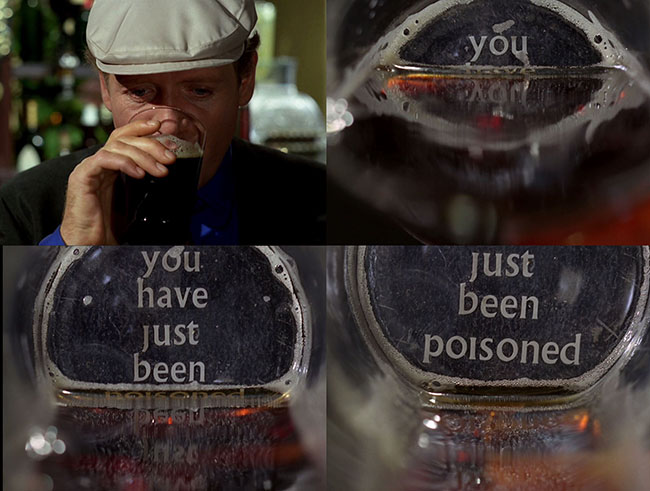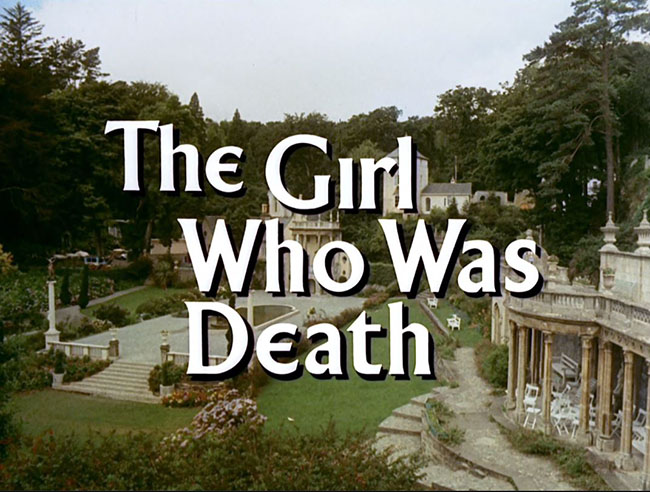THE GIRL WHO WAS DEATH First UK Broadcast: January 18, 1968 [episode #15 in transmission order] | Written by Terence Feely | Directed by David Tomblin
SYNOPSIS
While pursuing a madman with a rocket, a colonel is assassinated during a cricket match. Mr. X (Patrick McGoohan) is on the job after touching base with his contact, Potter (Christopher Benjamin). He offers himself as bait in another cricket match and successfully foils an assassination attempt, then begins to track the killer, a woman dressed in white who calls herself Death (Justine Lord). In fact she is Sonia, the daughter of the madman, Schnipps (Kenneth Griffith). Sonia teases Mr. X while she tries to kill him – first by poisoning him, then by trapping him in a steam bath. He follows her through a carnival, but she continues to escape his grasp. She leads him in a car chase to an abandoned town where he’s subjected to deadly trials in the shops of a butcher, a baker, and a candlestick maker (the candles emit a cyanide gas and explode if snuffed). He escapes each trap and steals aboard her helicopter as she flies back to home base: a lighthouse that’s a rocket in disguise. There the neurotic Schnipps and his minions dress as Napoleon while plotting to launch their rocket at London. Mr. X foils their plans, blowing up the rocket with Schnipps and Sonia still in it. This tale is revealed to be a picture book read by No.6 to the Village children. In the Green Dome, No.2 (Griffith) and his assistant (Lord) are frustrated that No.6’s story has revealed nothing of importance.
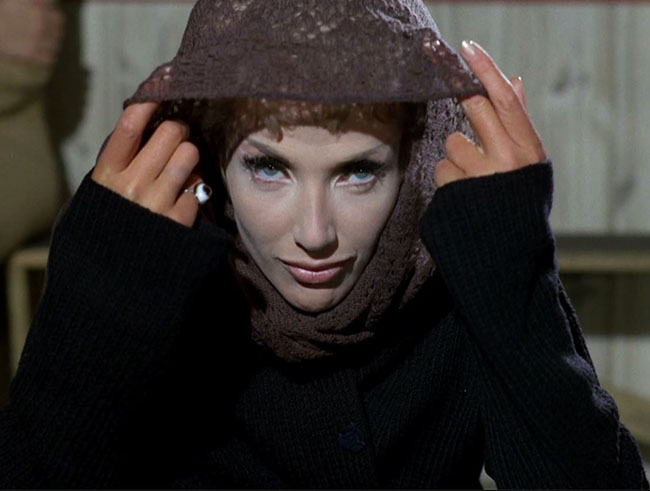
Sonia, the Girl Who Was Death (Justine Lord).
OBSERVATIONS
“The Girl Who Was Death” originated as a two-part script for Danger Man before the series was abruptly canceled due to its star’s departure. It shares much in common with how that final season had been shaping up with “Koroshi” and “Shinda Shima,” both over-the-top spy adventures in the James Bond, Avengers, and Man from U.N.C.L.E. vein, at odds with the usual seriousness that Danger Man exhibited. But now The Prisoner was coming to its own premature end, with its second order of episodes shortened to just four. (“Once Upon a Time” had already been filmed as part of the first batch.) Like two of those – “Do Not Forsake Me Oh My Darling” and “Living in Harmony” – we leave the Village greenery, as though Portmeirion had no more stories to offer. But “The Girl Who Was Death” has a markedly different tone than those episodes; The Prisoner was nothing if not varied. It’s very slight, but it’s a genuinely funny parody. In fact, it could be read as The Prisoner spoofing Danger Man, right down to the inclusion of Christopher Benjamin’s Potter, who had appeared in “Koroshi.” (By a remarkable coincidence, it even features an actor named John Drake.) Griffith had appeared in “Shinda Shima.” To add to the delirium, The Prisoner had been on a short break for a few weeks in January 1968, and those last two long-delayed, full color Danger Man episodes took the show’s place, followed by “The Girl Who Was Death” which began to air across the country on January 18. Therefore The Prisoner became Danger Man which then transitioned into this strange mix of the two, with overlapping actors and similar styles. If audiences had a hard time telling No.6 from John Drake, this wouldn’t help matters.
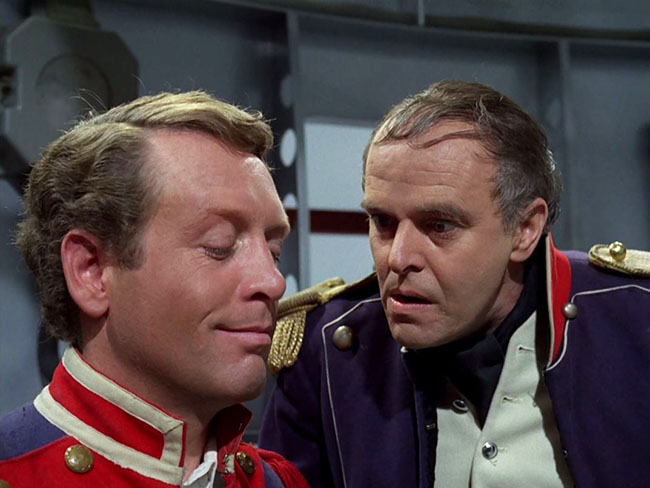
Mr. X (McGoohan) is held captive by Schnipps (Kenneth Griffith), whose Napoleon complex is quite literal.
If the episode can seem like a wasted opportunity – you have so few of these left, and you do this? – it almost compensates by being jam-packed with ludicrous traps and diversions, all filmed with a psychedelic eye by David Tomblin, who had last directed “Living in Harmony.” Tomblin is credited with the original “idea,” while the script is by Terence Feely (“The Schizoid Man“). Alexis Kanner, something of a mascot in these late episodes, makes a brief cameo as a photographer at the carnival, in league with Sonia. But in many ways Lord and Griffith steal the show. Lord sports a variety of oddball Swinging London fashions, most often in white; her most memorable involves a mod white kaiser helmet which she dons while wielding a bazooka. She taunts McGoohan throughout the episode, cooing seductively while threatening him: “I love you madly. I love the way the hair curls on the back of your neck. You’ll make a beautiful corpse.” Griffith relishes playing the comic buffoon – he even gets a little bit of Three Stooges business with his Napoleon-mimicking underlings, slapping the hands out of their coats. (Originally he was to be dressed as Hitler.) The Beachy Head Lighthouse where the climax takes place was last seen in “Many Happy Returns” as the spot where No.6 washes up. An obvious model is used when it’s blown to smithereens in the climax.
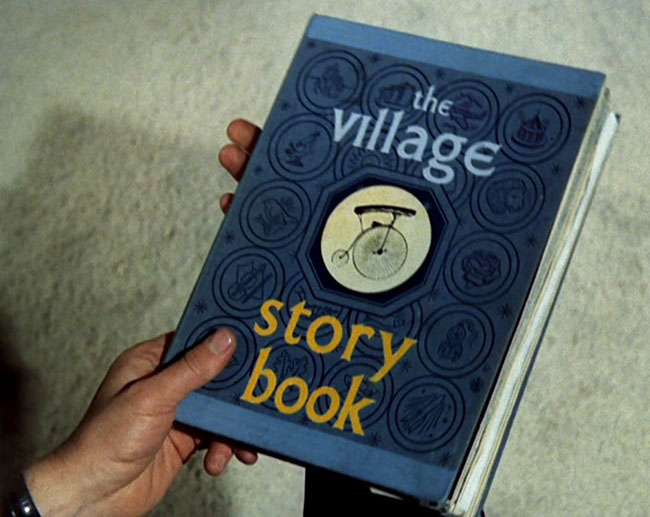
The Village Story Book read by No.6.
METHODOLOGY
No.6 is reading from “The Village Story Book” which seems to consist of pictures, no text. Apart from a picture of a cricket match, the vintage illustrations have only the loosest connection to the actual story he’s telling (we glimpse them at the commercial breaks – the big clue that this story isn’t really happening). For example, a picture of an old biplane is used when Mr. X and Sonia are traveling by helicopter, and a whaler harpooning a whale stands in for the climax. Griffith’s No.2 hopes to learn something about No.6 from this elaborate story he’s concocting out of thin air. I believe there might have been glimpses of children in the background of Portmeirion footage in earlier episodes, but this is the first time we’re properly introduced to the concept of children living here. The Village can accommodate an entire life, from this nursery to the Old People’s Home to the Graveyard. At the end of the story, No.6 says, “And that is how I saved London from the mad scientist.” Looking into the hidden camera, and so directly at No.2, he signs off: “Good night children – everywhere.”
SEQUENCE
This episode was the penultimate episode to be produced and aired fifteenth in both the U.S. and the U.K. With no direct ties to any other episode, it could be moved almost anywhere in your preferred order, but there’s no need. Originally I would go from “Hammer Into Anvil” straight into “Once Upon a Time” because that seemed to have a certain momentum, but I’ve reconsidered. “A Change of Mind” and “Hammer Into Anvil” are very dark episodes, dealing with lobotomies, suicide, and revenge. “Once Upon a Time” is the most intense hour of the entire series, and “Fall Out” is heavy, man. Therefore “The Girl Who Was Death” serves a purpose when placed here: it gives us a chance to take a break, catch our breath, and have some fun before we dive into the last two-parter and go looking for No.1.
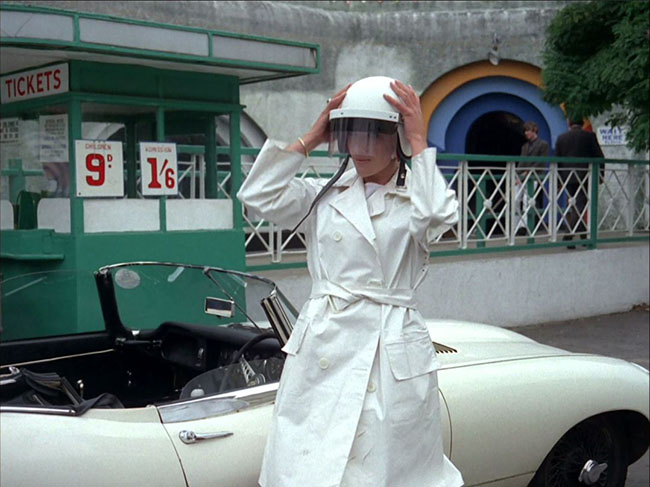
Sonia prepares to lead a race with Mr. X.
By now it should be obvious what my episode order is, so I want to lay it all out and explain the overall thinking. Some fans like to arrange The Prisoner using the production order as the best rule to follow; others prefer to look at No.2’s methods against No.6 to form an evolving narrative; still others try to follow internal clues in the series, such as calendar dates and telling dialogue. Throughout this episode guide I’ve been offering my own reasons for placing each episode where I have, and it’s been a hybrid of all three of those approaches. With this order, the series falls roughly into three phases:
I: Introductory Episodes, or: “I’m New Here.” These include “Arrival” and the episodes that the writers intended to follow “Arrival” closely. I’ve spotlighted the internal clues in my individual reviews.
P: Prisoner’s Past. Key episodes focus on illuminating who the Prisoner really is and where he came from, with visits to London both real and faked. (Yet we still don’t learn why he resigned.)
D: Destroying the Village from Within. Having learned he can’t escape, No.6 begins to sabotage and dismantle the works, which leads to a final reckoning. These episodes include the two-part finale.
Here’s my episode sequence, and you can see how the types I, P, and D roughly align to tell the Prisoner’s story.
1. Arrival (I)
2. Free for All (I)
3. Checkmate (I)
4. Dance of the Dead (I)
5. The Chimes of Big Ben (P)
6. The Schizoid Man (-)
7. Many Happy Returns (P)
8. The General (-)*
9. A. B. and C. (P)
10. Do Not Forsake Me Oh My Darling (P)
11. It’s Your Funeral (-)
12. Living in Harmony (-)
13. A Change of Mind (D)
14. Hammer Into Anvil (D)
15. The Girl Who Was Death (-)
16. Once Upon a Time (D)
17. Fall Out (D)
*”The General” could be listed as an early example of D.
QUOTES
Sonia: Mountaineering rope. It would hold an elephant.
Mr. X: I must remember that the next time I go climbing with one.


THE OPENING CREDITS
The famous opening titles of The Prisoner gave an early warning to Danger Man viewers that this was going to be very unique from the show they loved. Almost every episode opens with the image of storm clouds: there’s trouble ahead. Thunder crashes on the soundtrack. Then, an empty road in a desolate landscape; for a moment we see nothing, until a Lotus Seven rockets at the camera. This is the Lotus Cars test track near the Lotus factory in Hethel, Norfolk. A close-up of Patrick McGoohan follows, smiling enigmatically. As he drives through London and turns into an underground garage (located in Abingdon Street), the catchy Prisoner theme makes its debut. The theme is by Australian composer Ron Grainer (1922-1981), who is best known for the theme to Doctor Who, but was a prolific and wide-ranging contributer to British film and TV. The theme suits the personality of McGoohan’s character: confident, brash, and even reckless – there’s so much going on that it almost crosses the line into chaos. Instead, it will just get stuck in your head.


When the Prisoner enters the office occupied by script editor George Markstein’s pen-fiddler, thunder crashes again on the soundtrack as the Prisoner smashes his fist on the table and tenders his resignation, demonstrating how thunderous Grainer’s theme really is. In the rough cuts featuring the original, abandoned theme (“Chimes”) by Wilfred Josephs, the thunder is more dominant, and the music takes longer to commence. When it does, Josephs provides a very bizarre, off-kilter composition that perhaps matched the surreal tone of the series but was too discordant for what was intended to be popular entertainment. Even Grainer’s theme had to be punched up, playing too gently in its original version. McGoohan resigns before Markstein after pacing back and forth like an animal (ironic, because as production wore on, a frustrated Markstein would be submitting his resignation to McGoohan). He exits the garage in his Lotus Seven, and we see a teletype machine typing symbolic X’s across an old promo portrait of McGoohan as John Drake. The picture is dropped into a file by a mechanical arm. Danger Man is certainly finished.



Now peculiar things begin to happen. He’s followed by a Bentley (S-Type Standard Steel Saloon), which pulls up behind him when he parks on the street at his home, No.1 Buckingham Place. While he packs and the title finally appears on the screen, a tall man in a top hat emerges from the Bentley. (We’ll see him again in “Do Not Forsake Me Oh My Darling.”) A clue as to where he’s going: a travel brochure with a palm tree and a beach is packed in luggage. Gas shoots through the keyhole in the front door, and No.6 sways and falls. Here is where “Arrival” picks up, though in subsequent episodes we’ll get a summary of his new situation in the Village.



The flat looks the same, but when he pulls up the blinds, he sees the Village square. A globe chair rises in No.2’s quarters, beginning an intrusive theme of circles: its circle eclipses the great wheel of the penny-farthing bicycle behind it. After we see No.6 running along the beach, a bubble blossoms up from underwater, become the white sphere of Rover. The globe chair (its occupant unseen) watches Rover bounce along the beach, knocking No.6 off his feet. Another circle: the eye-shaped camera of the Supervisor’s chamber, with its see-saw apparatus which the observers ride. Back on the beach against a darkening sky, No.6 strikes out at the world: “I am not a number, I am a free man!” The dialogue over this second half of the credits is spoken by No.6 and No.2, but the No.2 is usually a generic one: Robert Rietty. This was particularly handy in episodes in which No.2’s identity is a surprise (“Many Happy Returns,” “The Girl Who Was Death”), in which case a close-up of this week’s No.2 would be omitted. Here is the full opening credits dialogue:
No.6: Where am I?
No.2: In the Village.
No.6: What do you want?
No.2: Information.
No.6: Whose side are you on?
No.2: That would be telling. We want information. Information. Information.
No.6: You won’t get it.
No.2: By hook or by crook, we will.
No.6: Who are you?
No.2: The new Number Two.
No.6: Who is Number One?
No.2: You are Number Six.
No.6: I am not a number, I am a free man!
No.2: (Laughter)
UP NEXT: ONCE UPON A TIME
